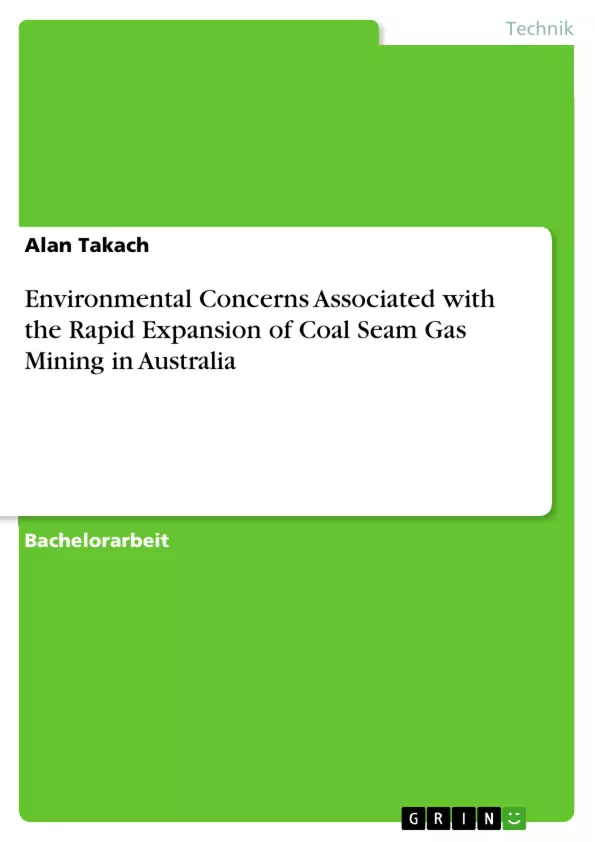Natural gas is expected to play an important role in Australia’s transition to a low-carbon economy. In comparison to coal, the combustion of natural gas generates half the greenhouse gas emissions and does not produce harmful by-products such as sulphur, mercury, fly ash and particulate matter. Despite this, the rapid expansion of coal seam gas mining in Australia has raised significant concerns amongst the community.
This project aims to determine if the production of CSG at commercially viable rates would adversely impact the environment, and if so, to what extent. An extensive literature review was undertaken and identified three main potential impacts associated with the rapid expansion of coal seam gas. These include; the fragmentation of agricultural land and habitat, groundwater contamination and diminished water supply, and emissions of greenhouse gasses. Case studies from the United States and Australia were also examined.
The study found that the majority of literature publications expressed some concern towards the rapid expansion CSG mining in Australia, however a high level of uncertainty exists as to their direct environmental impact. Without rigorous scientific studies, coal seam gas is expected to remain an uncontrolled risk, posing substantial threats to the environment in which we live. This study recommends that mitigation measures be applied in accordance with the precautionary principle, and that scientific research be undertaken to prevent the occurrence of serious or irreversible environmental harm. Research in this field will benefit the community through the identification of opportunities and challenges faced during the initial expansion of the CSG industry in Australia. Furthermore, the introduction of preventative measures will maintain the sustainability of our environment for future generations to come.
Inhaltsverzeichnis
- Chapter 1-Introduction
- 1.1 Background
- 1.2 Scope and Objectives
- 1.3 Methodology
- 1.4 Thesis Layout
- Chapter 2-Literature Review
- 2.1 Introduction
- 2.2 Unconventional Gas
- 2.3 Gas as a Transitional Fuel
- 2.4 Coal Seam Gas Development
- 2.5 The Eastern Gas Market
- 2.6 Coal Seam Gas Production Lifecycle
- 2.6.1 Exploration
- 2.6.2 Development and Production
- 2.6.3 Processing, Transport & Storage
- 2.7 Environmental Impacts
- 2.7.1 Fragmentation of Agricultural Land and Habitat
- 2.7.1.1 Loss of native biodiversity & displacement of wildlife
- 2.7.1.2 Soil erosion and reduction in water quality.
- 2.7.1.3 Invasion of non-native species
- 2.7.2 Contamination of Surface and Groundwater Resources
- 2.7.2.1 Groundwater Depletion
- 2.7.2.2 Groundwater Contamination
- 2.7.2.3 Surface Contamination
- 2.7.3 Emissions of greenhouse gasses
- 2.7.1 Fragmentation of Agricultural Land and Habitat
- Chapter 3- Discussion and Conclusion
- 3.1 Discussion
- 3.2 Conclusion
- 3.3 Recommendations for future studies
- Chapter 4 - Project Reflection
Zielsetzung und Themenschwerpunkte
Diese Arbeit untersucht die Umweltauswirkungen des rasanten Ausbaus des Kohleflözgasabbaus in Australien. Die Hauptziele sind die Bestimmung, ob die Produktion von CSG in kommerziell rentablen Mengen negative Auswirkungen auf die Umwelt hat, und wenn ja, in welchem Ausmaß.
- Die Auswirkungen des Kohleflözgasabbaus auf die Fragmentierung von landwirtschaftlichen Flächen und Lebensräumen.
- Die Risiken der Grundwasserverschmutzung und der Verringerung der Wasserversorgung durch den CSG-Abbau.
- Die Emissionen von Treibhausgasen, die mit dem CSG-Abbau verbunden sind.
- Die Rolle von CSG als Übergangskraftstoff im Kontext des Klimawandels.
- Die Notwendigkeit von Vorsorgemaßnahmen und wissenschaftlicher Forschung, um die Umweltauswirkungen des CSG-Abbaus zu minimieren.
Zusammenfassung der Kapitel
Kapitel 1 führt in das Thema ein und erläutert den Hintergrund, die Ziele und die Methodik der Arbeit. Kapitel 2 bietet einen umfassenden Literaturüberblick zu unkonventionellem Gas, dem CSG-Abbau und dessen Umweltauswirkungen. Es untersucht die Auswirkungen auf die Fragmentierung von Land und Lebensräumen, die Kontamination von Grundwasser und die Emissionen von Treibhausgasen. Kapitel 3 diskutiert die Ergebnisse der Literaturrecherche und kommt zu dem Schluss, dass der CSG-Abbau erhebliche Umweltbedrohungen birgt. Es werden Empfehlungen für zukünftige Studien gegeben, um die Umweltauswirkungen des CSG-Abbaus zu minimieren. Kapitel 4 bietet eine Reflexion über das Projekt und die gewonnenen Erkenntnisse.
Schlüsselwörter
Kohleflözgas, CSG, Umweltauswirkungen, Fragmentierung von Lebensräumen, Grundwasserverschmutzung, Treibhausgasemissionen, Nachhaltigkeit, Übergangskraftstoff, Vorsorgeprinzip, wissenschaftliche Forschung.
- Arbeit zitieren
- Alan Takach (Autor:in), 2016, Environmental Concerns Associated with the Rapid Expansion of Coal Seam Gas Mining in Australia, München, GRIN Verlag, https://www.grin.com/document/342319



